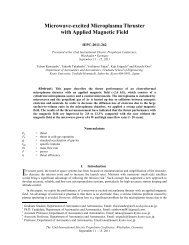Development of a Magnesium and Zinc Hall-effect Thruster
Development of a Magnesium and Zinc Hall-effect Thruster
Development of a Magnesium and Zinc Hall-effect Thruster
You also want an ePaper? Increase the reach of your titles
YUMPU automatically turns print PDFs into web optimized ePapers that Google loves.
Fig. 2. Mass flow as a function <strong>of</strong> temperature for bismuth, magnesium, <strong>and</strong> zinc<br />
with the horizontal dashed line indicating the temperature that each propellant<br />
must be to evaporate at 1 mg/s. 4<br />
II. Goal <strong>of</strong> Study<br />
The goal <strong>of</strong> the research reported here was to demonstrate the ability to operate a magnesium <strong>and</strong> zinc <strong>Hall</strong><strong>effect</strong><br />
thruster by directly sublimating propellant from solid magnesium <strong>and</strong> solid zinc. The preliminary findings<br />
will be presented from pathfinding experiments that were performed with consumable anodes. Following the initial<br />
results, data is presented from a hollow/porous anode design while implementing shim anodes in the discharge<br />
channel to control the propellant temperature.<br />
III. Description <strong>of</strong> Apparatus<br />
The thruster used for the experiments reported here was a modified Aerojet BPT-2000 <strong>Hall</strong>-<strong>effect</strong> thruster.<br />
While the overall geometry <strong>and</strong> magnetic circuitry <strong>of</strong> the BPT-2000 was preserved, the interior boron nitride (BN)<br />
body <strong>and</strong> anode structure were modified to accommodate the inner <strong>and</strong> outer shim anodes as well as the new<br />
magnesium, zinc, <strong>and</strong> porous anodes. 9 The main thruster components <strong>and</strong> anodes are shown in Fig. 1.<br />
Although magnesium <strong>and</strong> zinc cathodes were demonstrated, the electron source that was used when operating<br />
the thruster tests reported was a laboratory cathode fabricated in the Isp Lab with a LaB6 thermionic emitter. The<br />
cathode was operated on argon for all tests reported here. The cathode body is made <strong>of</strong> titanium <strong>and</strong> measures<br />
approximately 25 mm in diameter by 100 mm long. The cathode orifice is 4 mm in diameter <strong>and</strong> the propellant used<br />
was argon. A tungsten keeper electrode was placed approximately 3.5 mm from the cathode face. A schematic <strong>of</strong> the<br />
cathode can be seen in Fig. 3<br />
The 31 st 4<br />
International Electric Propulsion Conference, University <strong>of</strong> Michigan, USA<br />
September 20 – 24, 2009






